The maze of meaning: Interpreting Job through imagery in Leiden, UB, BPL 100 A
Leiden, UB, BPL 100 A, a glossed (annotated) copy of the biblical Book of Job dating from the twelfth century contains a number of sketches. What can these tell us about the interpretation of Job’s suffering in the Middle Ages?
Interpreting the Bible in the Middle Ages
In the Middle Ages understanding the Bible was no simple task. Every word of the Bible was open to analysis on multiple levels, as scholars sought to decipher the literal, allegorical, moral (or tropological) and spiritual (or anagogical) meanings of the text, and reveal its hidden messages. This four-fold manner of interpreting scripture had a long heritage which can be traced back to the writings of John Cassian (369-435), and was summarised in the Middle Ages in the following short verse:
‘Littera gesta docet,
Quid credas allegoria.
Moralia quid agas,
Quo tendas anagogia.’
‘The letter teaches events, allegory what you should believe, morality what you should do, anagogy what mark you should be aiming for.’ (De Lubac, trans. Sebanc, p. 1)
Understanding the various but co-existing meanings of scripture was a goal as well as a practical method. As Gregory the Great (c. 540-604) argued, interpretation had to be done by degrees, with the literal meaning underpinning the allegorical, which was, in turn, coloured by the moral. Gregory described his method by means of an architectural metaphor: ‘First we put in place the foundations of literal meaning; then through typological interpretation we build up the fabric of our mind in the walled city of faith; and at the end, through the grace of our moral understanding, as though with added colour, we clothe the building.’ (Carruthers, p. 18)
From the early twelfth century onwards, thanks to the initiatives of scholars such as Anselm (d. 1117) and his brother Ralph (d. c. 1133) at the cathedral school of Laon, interpretations of individual books of the Bible came to be systematically collected and collated into sets of annotations. These annotations would come be known as the so-called Glossa ordinaria, or Ordinary Gloss to the Bible. The Gloss, which offered multiple-level interpretations, was compiled of excerpts from the writings of the church fathers like Augustine (354-430) and Gregory, as well as from medieval writers like Bede (c. 673-735). It would become a standard intellectual resource at the theological schools of Paris (the precursor institutions to the University of Paris) and glosses to individual books of the Bible survive to this day in thousands of manuscripts (Smith, 2009). Through these annotations, the words of the Bible became accessible, even demystified, with their interconnections and cross-referents laid bare.


BPL 100 A: A glossed book of Job
There are a number of glossed Biblical books at Leiden University Libraries, but the subject of this post is a twelfth-century copy of the Book of Job, now BPL 100 A. This book recounts the sorry tale of Job – a virtuous man who was tormented by Satan, lost all his possessions and his family, was struck down by disease, but still refused to curse God for his misfortune. The Leiden manuscript tells his story across fifty-eight folia, with the biblical text central on the page, surrounded by dense marginal and interlinear annotations. As Lesley Smith, who has studied the medieval glossing tradition of the Bible in detail, has established, the Gloss to Job depended heavily on a commentary written by Gregory the Great, the Moralia in Job (Smith, 2016). Gregory’s commentary was a massive work, often copied by medieval scribes in multiple volumes; the Gloss text served as a handy reference: condensed, excerpted and stripped to its essentials.
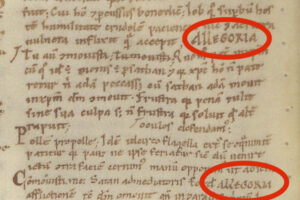
The ratio of commentary to biblical text in this manuscript is immediately striking. The layout of the page, with the Book of Job presented in a single column accompanied by short passages of commentary, allowed the user to consult text and interpretation simultaneously. The reader could find the relevant interpretation by locating the lemma (a brief excerpt from Job) at the start of each passage of annotations, facilitating cross-reference. In this manuscript, not only are the margins of the pages sometimes filled to the brim with annotations, but additional part-leaves of parchment have been added throughout to supply extra text. The glossator even indicates the type of interpretation, adding the words ‘MORALITER’ (‘morally’) and ‘ALLEGORIA’ (‘allegory’) in majuscule letters throughout.
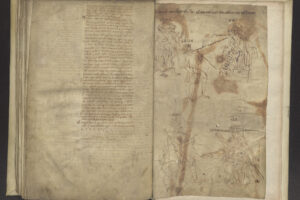

Cartoons in context
In terms of their textual content, glossed biblical books achieved a certain standardisation by the late twelfth century, but the manuscripts remained open to personalisation, as is evident in BPL 100 A. At its conclusion, a leaf of parchment, slightly smaller in dimensions than the rest of the manuscript, was added, containing a set of drawings (f. 59r). These almost cartoonish sketches portray two scenes from the opening of the Book of Job (1:6-7).
At the top of the page, the scene is set with a caption, quoting directly from Job 1.6:
'Quadam die, cum uenissent filii dei ut assisterent coram domino, adfuit inter eos satane’. (‘One day, when the sons of God came to stand before the Lord, Satan was present among them.’) The figures in the first set of pen drawings are labelled, with the ‘filii Dei’ (the sons of God) on the left, Satan standing before (and separated from) them, with God seated, leaning slightly forward, on the right. As in a comic strip, the drawing abstracts the dialogic components from the biblical text, with each character ‘speaking’ their part, with their words emanating from their mouths. God asks, ‘Vnde uenis?’ (‘Where have you come from?’); Satan responds: ‘Circuiui terram, et perambulaui eam.’ (‘I have gone around about the earth and walked through it.’)
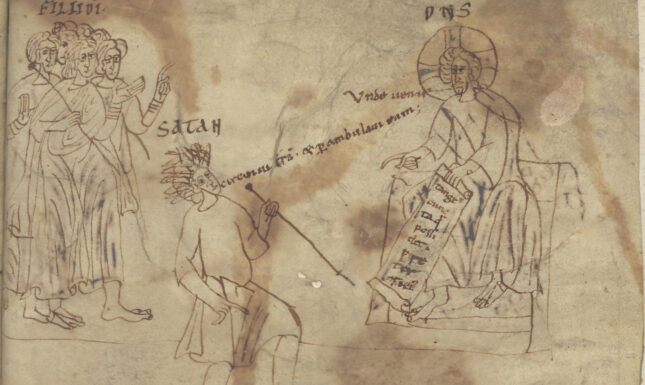

In the text Satan contends that Job would curse God if all that he had was taken away. He asks God to ‘touch all that he has’ (‘tange cuncta quae possidet’). In the image, these words are taken out of Satan’s mouth and transposed to the scroll in God’s left hand, which finishes with the almost illegible words ‘pr[a]eter [?] eius’, (‘besides his [?]’). The central word here is difficult to read, but we can assume its meaning by what is agreed - ultimately Satan is permitted to bring destruction to Job’s livelihood and family, even to his body, but not to his soul. The transposition of Satan’s words in the text to the scroll in God’s hands underscores an important point of the story – Satan (called ‘the accuser’ in some English translations) is Job’s tormenter, but he acts with God’s permission. By presenting the words on the scroll, a written medium held firmly in God’s hands, the artist accords the words extra authority over the “spoken” dialogue; God is the one who controls this narrative.
In the lower half of the page, the scene changes and we are confronted with the unfortunate Job, who sits, labelled with his name, on the right. Satan, wordless, points at him, with a rod in his other hand. Job’s hands are also outstretched and he gestures (holding a crutch) towards Satan. He refuses to curse God, but says, ‘the Lord gave, and the Lord took away: as it pleased the Lord so is it done’ (‘Dominus dedit, Dominus abstulit; sicut Domino placuit, [ita factum est]’ – the last words are obscured by a fold on the parchment). The viewer is left to fill in the blanks – the devastation visited on Job is not shown.
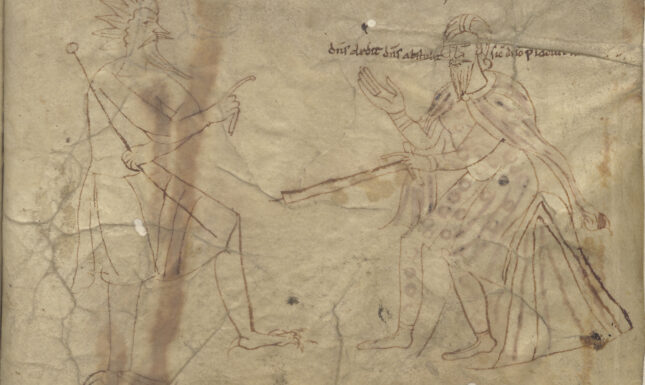

It’s tempting to speculate about the audience of this image and its artist. Was it drawn to entertain or to explain? In her study of pen drawings in the Middle Ages, Melanie Holcomb noted a sketch of Job and his wife which was drawn on what is now a pastedown on the cover of a copy of Gregory the Great’s Moralia in Job (Vienna, ÖNB, Cod. 673). Holcomb suggested that these figures, also dating from the twelfth century, which ‘float without context on a compromised piece of parchment’, may have been trial sketches. Although uncertain of their final purpose, she concluded that ‘the drawing’s beauty was surely recognised, for it was preserved’ (Holcomb, 2009, p. 24) Similarly, we can’t be sure of what the overarching intention of the artist of BPL 100 A was, but, by design or not, in providing a visual complement to the textual commentary they augmented and enlivened this codex.
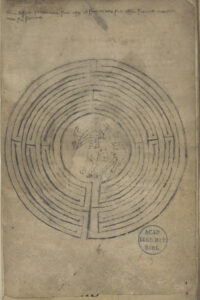

The interpretative maze of the labyrinth
BPL 100 A contains one further drawing at its opening (f. 1r): a labyrinth with a minotaur-esque figure at its heart. Given that the sheet appending the drawings of Job and Satan was clearly an addition to the manuscript, while this drawing was made on the (formerly blank) recto of its first page, we cannot assume that the same artist was responsible for both sets of drawings. Moreover, the figure at the heart of the labyrinth is rubbed and indistinct, making direct comparison of style a challenge (although the ink here is notably darker). Labyrinths are common images throughout the Middle Ages (Reed Dobbs’s study at p. 134 refers to seventy-four examples in manuscripts alone), and they are used in a wide variety of contexts to signal (cosmic) order but also complexity. The presence of the beast at its centre does not necessarily suggest that this labyrinth must exclusively be read within the classical tradition; the twelfth-century pavement labyrinth in the church of San Michele Maggiore in Pavia also contained an image of Theseus and the minotaur at its centre, drawing a parallel, Reed Dobbs argues, with the harrowing of hell (Reed Dobbs, 1990).
But what prompted its addition here at the start of this glossed copy of Job? Was it just a proficient sketch, carried out on a convenient blank piece of parchment, or did the scribe see any connection between it and Job’s story, encouraging the viewer to seek moral and allegorical parallels? It’s likely that the medieval reader would have traced the route to the centre of this maze with their finger; I wonder whether this act brought the words of Satan in Job 1:6 to mind: ‘I have gone around about the earth and walked through it’, perhaps reminding the reader of the pervasion of suffering in the world? Or whether the artist viewed Theseus’ victory over the minotaur as a parallel to Job’s ultimate reward for his faithfulness to God - the return of his possessions and a long happy life? In contrast with the images at its conclusion, we can’t be certain of the association with Job’s story in this instance; as was probably the case for the medieval reader of this manuscript, its interpretation remains a challenging, multi-layered and often open game.
Further reading:
M. Carruthers, The Craft of Thought: Meditation, Rhetoric, and the Making of Images, 400-1200 (Cambridge, 1998)
M. Holcomb, ‘Strokes of Genius: The Draftsman’s Art in the Middle Ages’, in M. Holcomb (ed.), Pen and Parchment: Drawing in the Middle Ages (New Haven, 2009).
H. De Lubac, Medieval Exegesis, Vol. 1: The Four Senses of Scripture, trans. M. Sebanc (Grand Rapids, MI, 1988).
P. Reed Dobbs, The Idea of the Labyrinth from Classical Antiquity through the Middle Ages (Ithaca/London, 1990).
L. Smith, The Glossa Ordinaria: the making of a medieval Bible commentary (Leiden, 2009).
L. Smith, ‘Job in the Glossa Ordinaria on the Bible’, in F. T. Harkins and A. Canty (eds), A companion to Job in the Middle Ages (Leiden, 2016), pp. 101-128.
You can browse Leiden UB, BPL 100 A in full here. The spelling of transcriptions from the medieval Latin has not been normalised; abbreviations have been silently expanded. Unless otherwise stated, all images are from https://digitalcollections.universiteitleiden.nl.
© Irene O'Daly and Leiden Medievalists Blog, 2022. Unauthorised use and/or duplication of this material without express and written permission from this site’s author and/or owner is strictly prohibited. Excerpts and links may be used, provided that full and clear credit is given to Irene O'Daly and Leiden Medievalists Blog with appropriate and specific direction to the original content.


